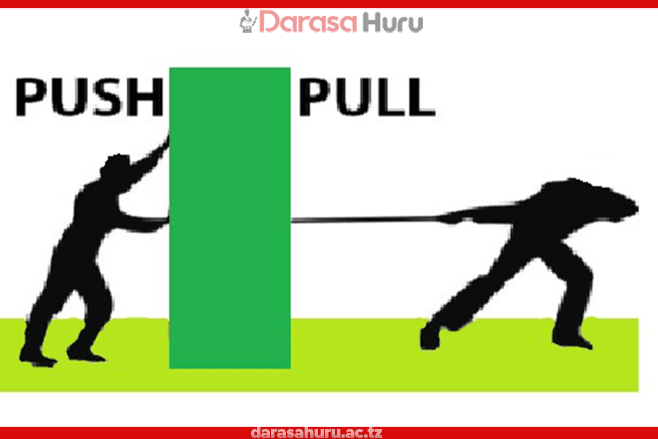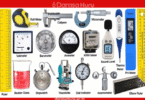Introduction to Force
The word force is often used in everyday situations. The interaction between two or more objects involves forces acting between them. Objects that are flying, hanging, balancing, moving, and spinning are all subjected to some kind of force.
Almost every activity you do in daily life requires the application of force. This means, there are several types of forces with different effects. Generally, it is hard to imagine a world without forces.
In this lesson, you will be introduced to different types of forces and their effects. The competencies developed will enable you to classify forces as well as effectively apply forces in your daily life.
Concept of force
If an object is at rest, it will remain in the state of rest unless some actions are performed to make it move. Similarly, if an object is in motion, it will require some actions to make it stop, otherwise it will keep moving.
For example, for a cart at rest to move, it needs to be pushed or pulled. Similarly, a stationary car should be pulled or pushed to make it move. The action of pushing or pulling objects to accomplish an intended task involves force. The Figure below shows pulling a cart and pushing a stationary car.
Pulling and pushing actions


(a) Pulling a cart (b) Pushing a stationary car
A force can therefore be defined as a push or pull experienced by an object. It is usually described in terms of its magnitude and direction. The SI unit of force is newton,N.One newton is the amount of force required to give a mass of one kilogramme (1 kg) an acceleration of 1 m/s2.
Therefore,1 N = 1kg × 1m/s2.
Effects of forces
An object is stationary when all forces acting on it are balanced. If a new force is applied to the object, the forces become unbalanced. The result of unbalanced forces on an object can cause various effects including:
(a) change in the state of motion of an object;
(b) change in the way the object moves;
(c) change of shape or size of the object; and
(d) change of direction in which an object is moving.
Activity 1
Aim: To demonstrate the effects of forces.
Materials: Carton of books, rubber bands, table and coil spring
Procedure
1. Move the carton of books from one end of the class to another without lifting it.
2. Stretch a rubber band until it is close to its breaking point.
3. Compress a coil spring between your hands.
4. Stretch the coil spring until it extends in length.
Question
In each case, what action makes an object change its shape or direction?

To move the carton of books, there is a need to either pull or push it. This means that a force has to be applied. The rubber band is pulled to stretch it while the spring is pushed to compress it. These activities demonstrate that pulling or pushing requires a force.
Determination of the magnitude of a force
A spring balance can be used to estimate the magnitude of force. It consists of a coiled spring fixed to a support at one end, with a hook at the other end as shown in Figure (a) below.

The body upon which the force acts is attached to the hook. The distance through which the spring is stretched is directly proportional to the magnitude of the force applied by the body.
A pointer is attached to the spring and the magnitude of force is indicated on a calibrated scale. The larger the force, the more the spring is stretched and the higher the reading on the scale. The spring balance can be used to measure vertical and horizontal forces acting on a body, as shown in Figure (a) and (b).

Spring balance used to measure forces
In Figure (a), the weight of the empty box is shown by the pointer on the spring balance. If you weigh the same empty box filled with sand the pointer will indicate a greater weight than that of the empty box.
This is because the weight of sand adds to the weight of the box. To get the weight of sand you need to subtract the weight of the box from the weight of the empty box filled with sand.
Types of forces
Some forces in the environment occur naturally while others are derived from natural forces. The naturally occurring forces are known as fundamental forces while the derived forces are referred to as non-fundamental forces.
The four fundamental forces are the force of gravity, electromagnetic force, strong force, and weak force. All other forces are derived from these fundamental forces. Examples of derived forces are elastic and frictional forces. Depending on the interaction between objects, all forces can be classified as non-contact or action-at-a-distance forces and contact forces.
Force of gravity
The force of gravity is the force of attraction between objects which have mass. All objects having mass are pulled towards the earth’s centre by the earth’s force of gravity.
It is because of the earth’s force of gravity that bodies in the air move towards the earth’s surface despite their sizes. For example, fruits fall from a tree because of the earth’s gravitational force. Human beings can walk properly because of the earth’s force of gravity.
The magnitude of the gravitational force exerted on an object is referred to as the weight of an object. It is represented by the symbol w and measured in newton (N). The weight of an object is the product of its mass, m and acceleration due to gravity, g.
weight (w) = mass (m) × acceleration due to gravity (g)
Normally it can be written as,
w = mg
Where, w – Weight of object
m – Mass of object
g – Acceleration due to gravity
Weight is defined as an attractive force acting on an object due to gravity.
The weight of an object is equal to the gravitational force on it.
The properties of the gravitational force:
1. It is always attractive.
2. It is the weakest force among the four fundamental forces.
3. It is a central force (gravitational force between two objects act along the line joining the centres of the objects).
4. It operates over very long distances.
Your weight on earth is the gravitational force that the earth exerts on you. Remember that gravity is an action-at-a-distance force, so even when you jump into the air, as shown in Figure below, the earth still exerts its gravitational force on you.
This is the force that prevents you from flying off on a spinning earth. The gravity force is also responsible for keeping a satellite in its orbit around the earth and planets in their orbits around the sun.

Task 1
After learning about physical quantities, a student argues that mass and weight represents the same physical quantity. With reasons, support or oppose this argument.
It should be understood that, the weight of an object is related to its mass. For instance, on the earth’s surface, an object with a weight of 1 N has also a mass of approximately 0.1 kg or 100 g. The ratio of weight (N) to mass (kg) gives approximately 10 N/kg which is always constant and is represented by “g”.
So, g has two meanings:
1. It is the gravitational field strength of the earth (10 N/kg); and
2. It is the acceleration due to gravity (10 m/s2).
Near the earth’s surface, there is a force of gravity of 10 newtons for each kilogram of mass (see Figure 3.5). Thus, the earth’s force of gravity is 10 newtons per kilogram (10 N/kg).
Note that, the acceleration due to gravity varies depending on the reference body. For example, the acceleration due to gravity on the moon gm is equal to one-sixth of the acceleration due to gravity on the earth, ge.
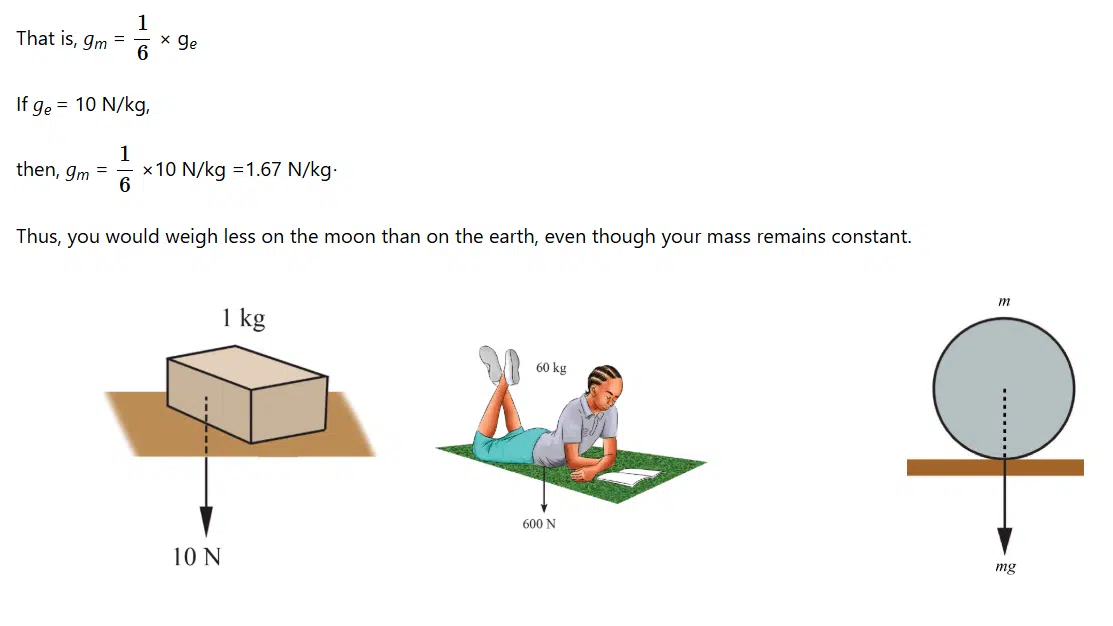
Example 1
Assume a fixed mass rocket in Figure below, moves from the earth to a planet X. If it weighs 10 000 N on the earth and 300 N on planet X, determine the acceleration due to gravity on planet X.

Solution
Let the weight on the earth be we.
So, the weight of the rocket on earth is
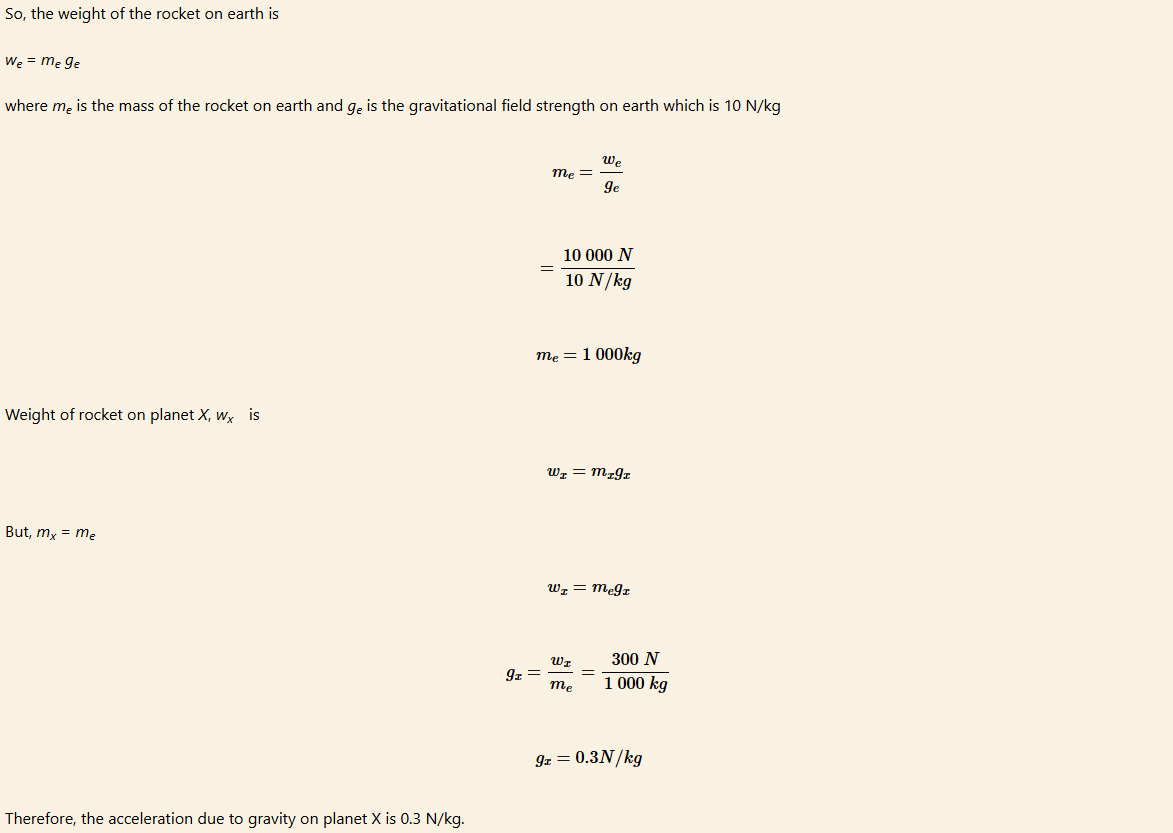
Activity 2
Aim: To measure a force using a spring balance.
Materials needed: Spring balance, various objects of different weights (e.g., small weights, books, fruits, etc.), table or any other hard flat surface, cushioned surface
Procedure
1. Place the table or hard flat surface at an appropriate area for the activity.
2. Vertically attach the spring balance securely to the hard surface.
3. Hang an object from the spring balance, allowing the spring to stretch.
4. Record the reading on the spring balance.
5. Repeat steps 3 and 4 for different objects.
6. Present all the measurements in tabular form.
7. Now, remove the spring from the hard surface and attach it to the cushioned surface.
8. Repeat steps 3 to 6 while observing the surface deformation.
9. Present your results using Table 3.1.
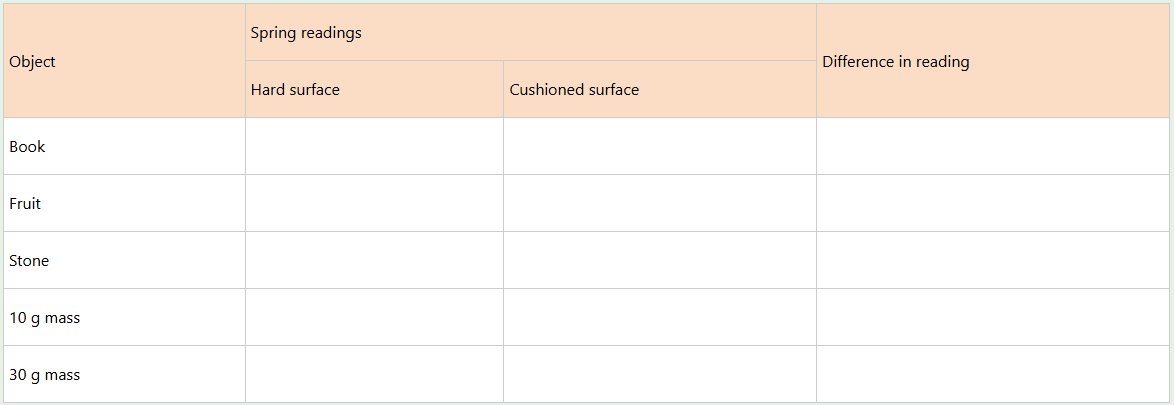
Questions
(a) How can you accurately measure the force of gravity using spring balance.
(b) Compare the readings on the spring balance when used on the cushioned surface and when the spring is attached to the hard surface. Account for the difference.
(c) How is the absorption and deformation of the cushioned surface affect the accuracy of the spring balance’s readings.

The flat surface allows the spring balance to accurately measure the force of gravity, while the soft, cushioned surface interferes with the measurement as part of the force is absorbed by the surface when it deforms. This is why you feel less pain when you fall on a cushioned surface.
Activity 3
Aim: To demonstrate how the force of gravity varies with depth underwater.
Materials needed: Clear container (fish tank or large glass or plastic container), water, spring balance, objects of different weights, string, paper clips (for attaching objects to the spring balance)
Procedure
1. Fill the clear container with water.
2. Attach various objects of different weights to the spring scale using the string or paper clips.
3. Record the weights of different objects in air.
4. Submerge the spring scale and attached objects in the water, making sure they don’t touch the sides or bottom of the container.
5. Observe and record the readings on the spring scale for each object when submerged.
6. Present your results in Table below
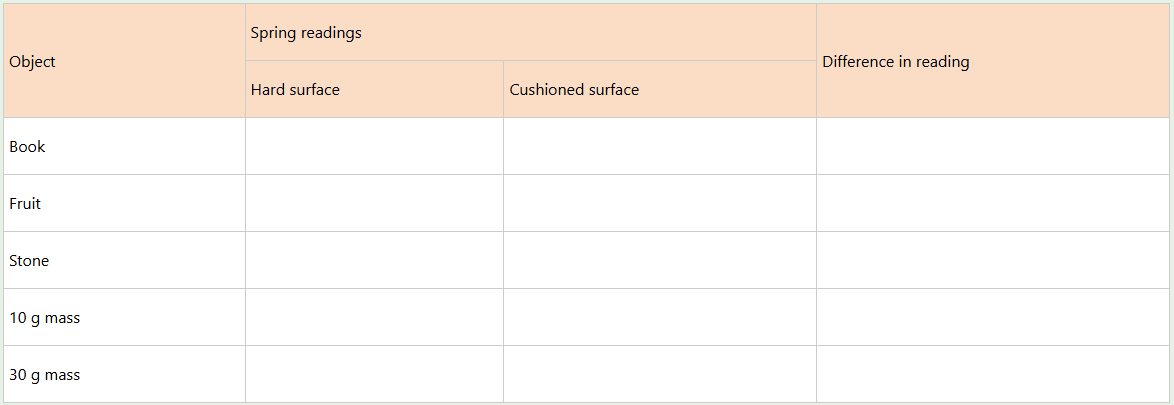

Electromagnetic force
This is a force that includes both electric and magnetic forces. It is relatively stronger than the force of gravity.
The following are examples of situations where electromagnetic forces are involved:
(a) In the formation of molecules of a substance. Atoms attract each other to form molecules. This is due to electromagnetic forces.

(b) If two parallel wires carrying current are placed near each other, the electromagnetic force acts on the wires.

Properties of electromagnetic force:
(a) It is either attractive or repulsive in nature;
(b) It is a central force (originates from the centre or toward the centre);
(c) It is stronger than gravitational force;
(d) It is a long-range force (operates over a very long distance);
(e) Its strength decreases as the distance between the objects increases; and
(f) Its direction depends on the charges of the objects involved.
Strong force
This is a nuclear force that binds protons and neutrons together to form atomic nuclei. The action of strong force results in binding energy which can be felt when splitting a large nucleus into small fragments (fission) or combining two or more nuclei to form a bigger nucleus (fusion), as illustrated in Figure below

Nuclear fusion and fission
The strong force has the following properties:
(a) It is basically an attractive force.
(b) It is a short-range force (operates in a distance ranging from 0.7 femtometre (fm) to 2.5 femtometre (fm)).
(c) It is a non-central force (does not originate from the centre).
(d) It is stronger than gravitational force.
(e) It does not depend on charges of objects.
Weak force
This is a nuclear force which appears only in a certain nuclear process. The following are properties of the weak force: (a) It is much stronger than the gravitational force but weaker than the strong and electromagnetic forces. (b) It acts on a small range of about 0.001 fm to 0.01 fm.
Exercise 1
1. Is an astronaut in space completely weightless? Explain your answer.
2. How much do you weigh on the earth? Would you weigh the same on the moon? Explain your answer.
3. Estimate your mass on the earth. If you are standing on the moon, do you think your mass on the moon will be the same? Discuss your answers.
4. Find the mass of a student who has a weight of 600 N.
Contact forces
These are forces which require physical contact to occur. They include: stretching, compression or restoring, attraction, repulsion, torsion, friction, viscous forces, and air resistance.
These forces result from the interaction of fundamental forces. Each force has particular effects on the objects to which it acts. Hence, these forces are discussed based on their effects.
Frictional force
This is the force which opposes motion between two surfaces of objects in contact. Friction occurs when one surface of an object is resting or moving over another. Friction is a very common force.
Whenever one object slides over another object, friction tries to stop the movement. For example, if a block is made to rest on a table, its weight acts on the table. But if the block is tied with a string and made to slide (pulled) as shown in Figure 3.8, there is some kind of resistance to the movement of the block. This is the work of friction.

Sliding a block on the table top
Frictional force occurs depending on the nature of the surfaces of bodies in contact. Friction produces heat, as is the case in matchsticks. Wear and tear of car tyres and shoe soles are caused by friction. For example, Figure (a) shows new tyres and (b) shows worn tyres due to frictional force.


New and worn car tyres showing the effects of friction
Activity 4
Aim: To demonstrate frictional force.
Material: Wood blocks
Procedure
1. Rub the palms of your hands against each other. What do you feel?
2. Make tiny rails on the surfaces of the two wooden blocks.
3. Vigorously, rub the two blocks of wood against each other. What do you observe?
Questions
(a) Explain your observations.
(b) What is your conclusion?
When two objects in contact rub against each other, heat is produced. Frictional force, unlike other forces, produces heat.
Frictional force results to wastage of energy in the form of heat. In engines, friction can wear the moving parts resulting in poor performance of the engine.
Activity 5
Aim: To demonstrate the magnitude of friction
Materials required: brick, hook, and spring balance
Procedure
1. Tie a string around a brick and attach a hook to it.
2. Attach the spring balance to the hook as shown in Figure below

3. Place the setup on a flat smooth surface.
4. Slowly, pull the spring balance. Keep on increasing the force on the spring balance until the brick just start to move. Record the reading on the spring balance at the instant the brick begins to move.
5. Place the setup on a rough surface and repeat step 4.
Questions
Compare the magnitude of force obtained in 4 and 5. Are the values the same or different? Give reasons.

Coefficient of friction
In activity 3.5, you noticed that more force is needed to pull the brick placed on the rough surface than when it is placed on the smooth surface. This is due to the existence of a large friction on a rough surface than on a smooth surface.
In practice, no surface has no friction, rather, some surfaces have minimum friction while others have maximum friction. On rough surfaces, friction is more noticeable because the surface has maximum friction while on smooth surfaces the friction is minimal. The level of friction caused by a surface is expressed by the coefficient of friction.
The coefficient of friction is defined as the ratio of friction force to the normal reaction. It is represented mathematically as:
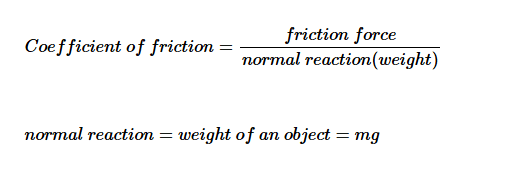
Example 3
What is the coefficient of friction, which is calculated in the context of a brick with a mass of 8 kg being pulled on a rough surface with a friction force of 26 N? (take g = 10 N/kg)

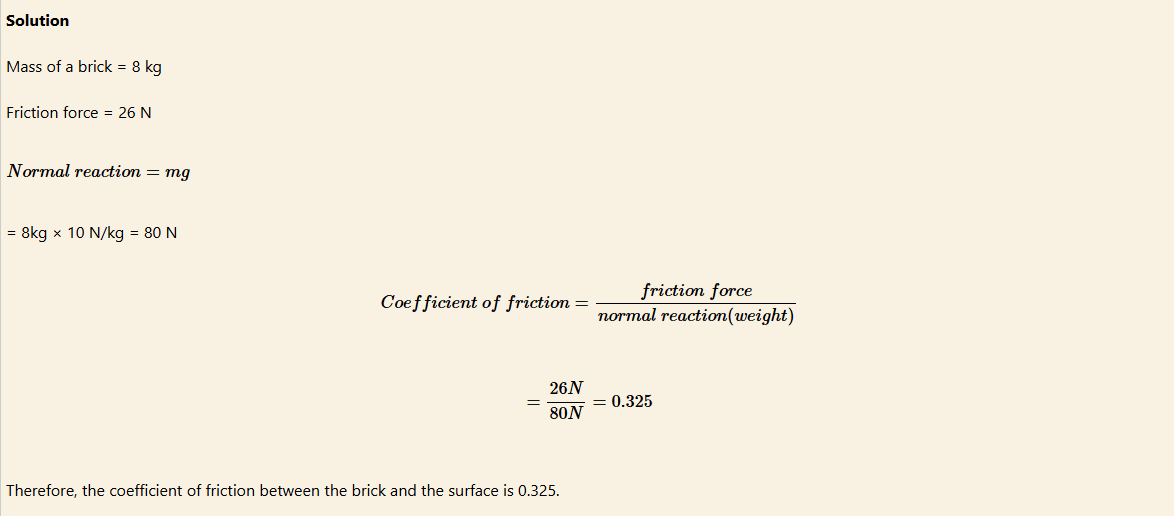
Stretching and compressional forces
Stretching force is the force exerted on an object when its two ends are pulled apart. On the other hand, compressional force is the force exerted on the body when its two ends are pushed towards each other.
Stretching and compressional forces are important in dealing with elastic materials, such as rubber bands, springs, wire, and ropes. Figures (a) and (b) show stretching forces on a rubber band and compressional force on a spring.

Stretching and compressional forces
Elastic (Restoring) force
Some materials tend to restore their original shapes and sizes when a force acting on them is removed. Such materials are said to be elastic materials. Examples of elastic materials are rubber bands and springs.
As one stretches or compresses an elastic material, such as a spring, it resists the change in shape. The material exerts a counter force in the opposite direction to the stretching or compressing force. This force is called elastic force.
As soon as the stretching or compressing force is removed, the elastic force causes the material to return to its original shape. Hence, the elastic force is also called a restoring force. Figure 3.12 illustrates the deformation and restoration of a spring.

Restoring force of a spring
Air resistance
Air resistance is the force that resists the movement of an object through the air. Air resistance is an example of fluid resistance or fluid force. It is the force exerted on an object moving through a fluid (liquid or gas). This force depends on the:
(a) size and shape of the object;
(b) speed of the object; and
(c) density of the fluid.
Air resistance is most noticeable in objects moving at high speeds or objects with large surface areas. For instance, a runner has to exert force to oppose the force of a blowing wind.
On the contrary, if the runner moves along the direction of the wind, the wind provides the force that increases his or her speed. Air resistance slows down many moving objects such as a car and even cyclists, as shown in Figure (a).
However, air resistance is advantageous to parachutists since it acts against the force of gravity on the parachute and slows its downward motion, as shown in Figure (b). A submarine, in Figure 3.14 must overcome air resistance above the water surface and water resistance beneath it.


Task 2
Discuss why engineers spend much time trying to reduce fluid resistance in cars, ships, and planes.
Viscous force
Viscous force is the resistance force provided by a fluid when it is subjected to a tangential force. The force acts to oppose the flow of the fluid past the object. From day-to-day observations, water has a smaller viscous force than cooking oil. On the other hand, honey has a larger viscous force than cooking oil.
The measure of resistance of the fluid to its flow past a surface is referred as the viscosity of the fluid. Thus, honey has a higher viscosity than water. Figure 3.15 shows how one can visually compare the viscosity of different fluids.


When a highly viscous liquid runs off a surface, its inner layer sticks to the surface so that the other layers have to slide over each other. Friction between the layers stops them from sliding easily, thereby making the whole liquid flow slowly.
Another effect of viscosity is that a highly viscous liquid will resist the motion of objects through it. High viscosity is a necessary property in lubrication. Lubricants like oil and grease are meant to reduce friction in the moving parts of machinery. Grease has a higher viscosity than oil.
Activity 6
Aim: To demonstrate viscosity of substances.
Materials: Water, cooking oil, honey or lubricating oil, beakers, stopwatch, plastic can and seal tape
Procedure
1. Clean a plastic can and drill a hole near the bottom.
2. Seal the hole using seal tape.
3. Fill in the can with water.
4. While starting the stopwatch, unseal the hole on the can.
5. Allow all the water to flow out from the can into the beaker. Record the time taken.
6. Clean the can, dry and reseal the hole.
7. Repeat steps 3 to 6, using oil and honey one at a time.
Questions
(a) Compare the rate of flow of the liquids.
(b) Account for the differences observed.

Oil takes longer time to flow into the beaker than water. On the other hand, it takes longer for honey to flow into the beaker than it does for cooking oil. Honey has a higher resistance to flow. Therefore, we can say that cooking oil is more viscous than water and honey is more viscous than cooking oil.
Tensional force
Tension is the force exerted on an object by a stretched material. It is the force that is transmitted through a string, rope, cable, or wire when it is pulled tight by forces acting from opposite ends.
The tension force is directed along the length of the wire and pulls outwards along the two ends of the rope. Figure 3.16 shows the tension force along the stretched cable wire.

Buoyant force
Buoyant force is the force that causes objects to float. It is the force exerted on an object that is partly or totally immersed in a fluid. Buoyant force is caused by differences in pressure acting on opposite sides of an object immersed in a static fluid as shown in Figure .
This is the reason why an object feels lighter when immersed in a fluid but heavier just above the surface of the fluid.

Normal force
This is a support force exerted upon an object which is in contact with another stable object. The normal force is also called reaction force and it acts perpendicular (at right angle) to the surface in contact.
For example, if a book is resting on a table, then the table is exerting an upward force on the book in order to support the weight of the book, as shown in Figure below

When a person leans against a wall, the wall supports the person by pushing him or her away perpendicular to the wall.
Torsional force
This is the force produced on a solid object when it is twisted. It is an elastic force since the object returns to its original shape when the force is removed. An example of torsional force is observed in twisting a rubber or a ruler, as illustrated in Figures below.

Illustration of torsional force
Task 3
1. Discuss the four types of contact forces and the properties of each type. State their uses in everyday life.
2. Hang two balloons on a wall side by side and allow them to touch each other. Rub each one of them with a dry cloth. What happens? Explain.
3. Place a bar magnet on a smooth table and then bring another bar magnet near it. What happens? Explain.
4. Starting with two bar magnets parallel to each other, rotate one bar magnet by 90° and bring it near the first magnet. What happens? Explain.
Chapter summary
1. A force is a push or pull experienced by an object. It results from the interaction between two objects.
2. Forces can cause a change in the:
(a) speed or direction of an object’s motion;
(b) shape and size of an object; and
(c) way an object moves.
3. Some forces act through physical contact between two objects while others act at a distance.
4. Force is measured in newtons (N).
5. A spring balance can be used to measure various forces, including weight.
6. Weight is a measure of the gravitational force exerted on an object.
7. There are four fundamental forces, namely:
(a) gravitational force;
(b) electromagnetic force;
(c) the strong force; and
(d) the weak force.
8. Forces produce several effects when in action. These include stretching, compressing, bending, and rotating or turning.
9. Friction is a resistance force that an object encounters when resting or moving over another object.
10. A compressional force is the force which when applied to an object result in a decrease of its size.
Revision exercise
Section A
1. Choose the most correct answer
(i) A force acting on an object causes some properties of the object to change. Which of the list contains properties that can be changed by the action of force?
(a) Mass, motion, and shape
(b) Mass, motion and size
(c) Mass, shape, and size
(d) Motion, shape and size
(ii)Figure (a) and (b) represents the beam balance and the spring respectively. A beaker in the right side balances the standard masses in the left side as shown in Figure (a). The beaker is then removed and hung from a spring as shown in Figure (b) the spring extends by 5.0 cm.

(a)

(b)
The experiment is then repeated using the same apparatus on the moon, where the acceleration of free fall is one-sixth that on Earth. Which statement describes what happens on the Moon?
(a) The beam balance is balanced and the spring extends by 5.0 cm.
(b) The beam balance is balanced and the spring extends by less than 5.0 cm.
(c) The right-hand balance pan is higher and the spring extends by 5.0 cm.
(d) The right-hand balance pan is higher and the spring extends by less than 5.0 cm.
(iii) In Physics test students were asked to mention the examples of friction.
The response of one candidate was as listed below.
1. tension in a spring
2. air resistance
3. weight
Which among the alternatives shows the correct examples of friction?
(a) 1 only
(b) 1 and 3
(c) 2 only
(d) 2 and 3
(iv) In an experiment to determine the weight of coloured water, a student was given a beam balance, beaker, and coloured water as shown in Figure 3.21. To do this, he/she has to measure the mass of empty beaker, pour some water in a beaker and measure the mass of beaker and water.

What is the weight of the water?
(a) 0.044 kg
(b) 0.168 kg
(c) 0.0044 N
(d) 0.44N
(v) A boy is pulling a box by a force of 100 N, if the frictional force experienced by the box is 20 N. what is the amount of force causing the motion of the box?
(a) 100 N (b) 120 N(c) 80 N (d) 5 N
(vi) It is fact that any object always has mass but does not always have weight. What must be present and acting on the mass for it to have weight?
(a) an acceleration due to gravity
(b) a set of scales for measurement
(c) displaced water in a beaker
(d) friction due to air resistance
(vii) The balls in Figure below have the same size. Which one will hit the ground first if they are dropped at the same time and at the same height?

(a) metal first, then wood, then plastic last.
(b) wood first, then plastic, then metal last.
(c) they will all hit at the same time.
(d) there is no way to tell.
(viii) A falling object is pulled down by the earth. The earth is pulled up towards the object. Why doesn’t the earth move?
(a) Because the earth has only gravity.
(b) Because the earth has a very large mass and a small acceleration.
(c) Because the earth has a very small mass and a large acceleration.
(d) Because air resistance gets in the way.
2. Match item in column A with its corresponding item in column B. Then, write the letter of the correct response in the provided space.
Section B
3. (a) The force of friction between the surface of a floor and the surface of a box in contact with the floor is 200 N. We wish to move the box on the floor with constant velocity. How much force has to be applied on the box?
(b) If a box has a mass of 80kg. Calculate the coefficient of friction?
4. (a) A student conducts an experiment to compare the weight of an object on Earth and the Moon. They find that the object’s weight is six times less on the Moon compared to Earth. Explain the difference in weight and why it changes on the Moon.
(b) If an object has a mass of 200 g on the Earth, how much would it weigh on the moon given that the acceleration due to gravity on the moon is one-sixth that of the earth?
5. Two students are pushing the wooden block laid on the table with forces as shown in Figure below

(a) Will the wooden block move? Which direction will the block move?
(b) How much extra force is acting on the object if the object is not moving due to the application of these two forces?
6. (a) Distinguish between the forces of attraction and forces of repulsion.
(b) Figure 3.24 shows part of a toy which contains two ring-shaped, permanent magnets. A plastic rod passes through the centre of both magnets.

The top magnet can move up and down freely around the plastic rod. The magnetic poles on the bottom magnet are shown in Figure 3.24.
(i) The top magnet floats in the air above the bottom magnet. On Figure 3.24 (a), mark the poles on the top magnet and explain why it floats in the air above the bottom magnet.
(ii) The top magnet is replaced with a ring made of iron as shown in Figure 3.24 (b). Explain why the iron ring sticks to the bottom magnet.
7. In each statement, suggest the type of force that comes into play.
(a) You placed two bar magnets close to each other, and they pushed each other away.
(b) You exerted a force on a book to move it across a table, but it eventually comes to a stop.
(c) If you drop a ball from a height, what force pulls it down towards the ground?
8. You want to lift a heavy box. The force of gravity pulls it downwards with 500 N.
(a) How much force will you have to apply to lift the box?
(b) If your friend supports the box from below with a force of 270 N, how much force will you have to apply to lift the box?
9. Why car dashboards are fixed with air bags?
10. A person pulls a cart with a force 1500 N.
(a) Will the cart move if the force of friction between the cart and the ground is 2000 N? why?
(b) Will the cart move if the force of friction between the cart and the ground is 1000 N? why?

